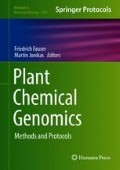Abstract
Strigolactones are a class of terpenoid-based plant hormones that are best known for their role in the suppression of axillary branching. However, strigolactones also play a role as stimulants for the germination of parasitic plants of the genera Striga and Orobanche. This dual role for strigolactones as endogenous hormones and interspecies signaling molecules has led to significant research directed toward understanding mechanisms of strigolactone perception from both the perspective of host plants and of their parasites. Antagonists for strigolactone receptors serve as potentially important tools in both arenas. This document describes the procedures required to use phenotypic screening approaches to uncover likely strigolactone receptor antagonists.
Access this chapter
Tax calculation will be finalised at checkout
Purchases are for personal use only
References
Park S-Y, Fung P, Nishimura N et al (2009) Abscisic acid inhibits type 2C protein phosphatases via the PYR/PYL family of START proteins. Science 324:1068–1071
Grossmann K (2010) Auxin herbicides: current status of mechanism and mode of action. Pest Manag Sci 66:113–120
Hopkins AL, Groom CR (2002) The druggable genome. Nat Rev Drug Discov 1:727–730
Santner A, Calderon-Villalobos LI, Estelle M (2009) Plant hormones are versatile chemical regulators of plant growth. Nat Chem Biol 5:301–307
Lumba S, Holbrook-Smith D, McCourt P (2002) The perception of strigolactones in vascular plants. Nat Chem Biol 13:599–606
Cook CE et al (1966) Germination of Witchweed (Striga lutea Lour.): isolation and properties of a potent stimulant. Science 154:1189–1190
Parker C (2009) Observations on the current status of Orobanche and Striga proble worldwide. Pest Manag Sci 65:453–459
Holbrook-Smith D, Toh S, Tsuchiya Y et al (2016) Small-molecule antagonists of germination of the parasitic plant Striga hermonthica. Nat Chem Biol 12:724–729
Stockwell BR (2004) Exploring biology with small organic molecules. Nature 432:846–854
Flematti GR, Scaffidi A, Waters MT et al (2016) Stereospecificity in strigolactone biosynthesis and perception. Planta 243:1361–1373
McNellis TW, von Arnim AG, Deng XW (1994) Overexpression of Arabidopsis COP1 results in partial suppression of light-mediated development: evidence for a light-inactivable repressor of photomorphogenesis. Plant Cell 6(10):1391–1400. https://doi.org/10.1105/tpc.6.10.1391
Tsuchiya Y, Vidaurre D, Toh S et al (2010) A small-molecule screen identifies new functions for the plant hormone strigolactone. Nat Chem Biol 6:741–749
Waters MT, Nelson DC, Scaffidi A et al (2012) Specialisation within the DWARF14 protein family confers distinct responses to karrikins and strigolactones in Arabidopsis. Development 1295:1285–1295
Tsuchiya Y, Yoshimura M, Sato Y et al (2015) Probing strigolactone receptors in Striga hermonthica with fluorescence. Science 349:864–868
Schneider CA, Rasband WS, Eliceiri KW (2012) NIH Image to ImageJ: 25 years of image analysis. Nat Methods 9:671–675
Author information
Authors and Affiliations
Corresponding author
Editor information
Editors and Affiliations
Rights and permissions
Copyright information
© 2018 Springer Science+Business Media, LLC, part of Springer Nature
About this protocol
Cite this protocol
Holbrook-Smith, D., McCourt, P. (2018). Chemical Screening for Strigolactone Receptor Antagonists Using Arabidopsis thaliana. In: Fauser, F., Jonikas, M. (eds) Plant Chemical Genomics. Methods in Molecular Biology, vol 1795. Humana Press, New York, NY. https://doi.org/10.1007/978-1-4939-7874-8_10
Download citation
DOI: https://doi.org/10.1007/978-1-4939-7874-8_10
Published:
Publisher Name: Humana Press, New York, NY
Print ISBN: 978-1-4939-7873-1
Online ISBN: 978-1-4939-7874-8
eBook Packages: Springer Protocols

